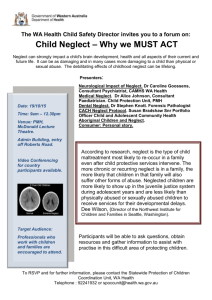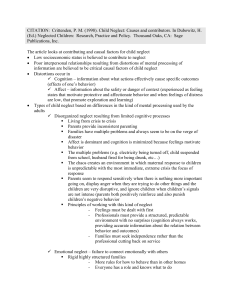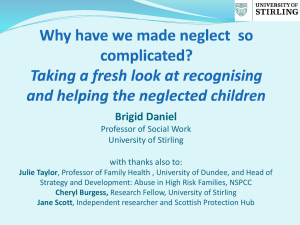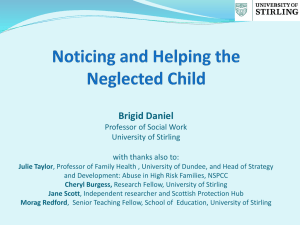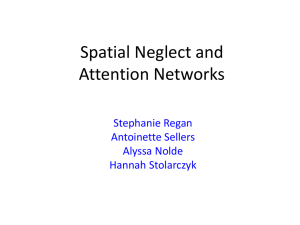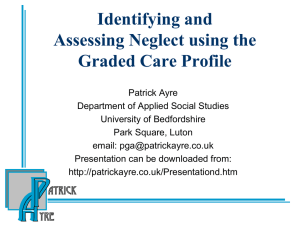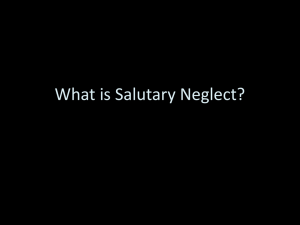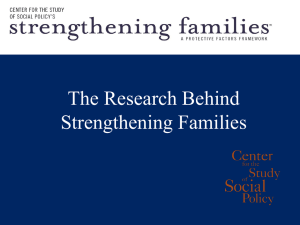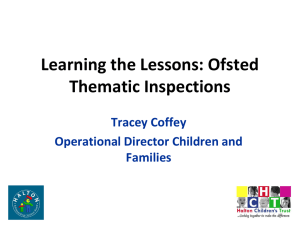Workshop 2 Presentation – Impact on adolescents
advertisement
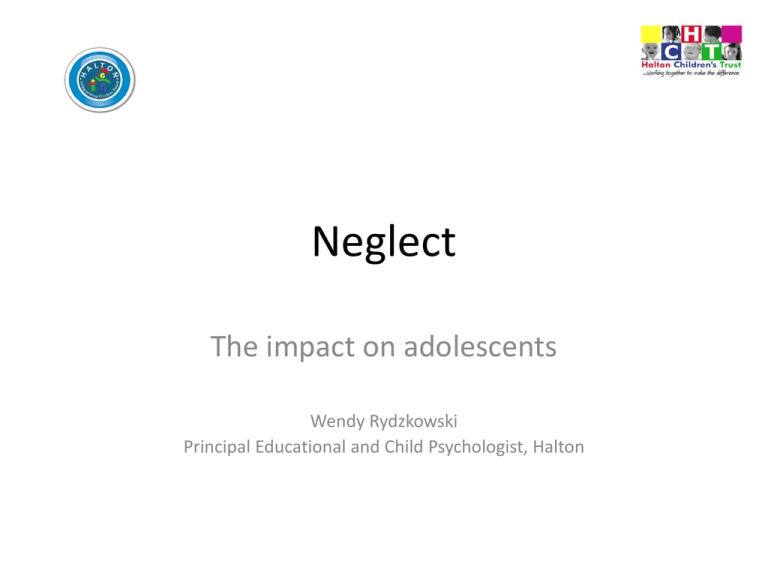
Neglect The impact on adolescents Wendy Rydzkowski Principal Educational and Child Psychologist, Halton What is adolescence? • “The awkward period between sexual maturation and the attainment of adult roles and responsibilities.” Ronald Dahl. Cognitive and Emotional Adolescence is a developmental period when new links are established in the brain that create connections between affective and cognitive processes. • Reasoning • Logic • Abstract thinking • Planning • Inhibition Passion, sport, hobby, idealistic causes Neglect in adolescence • Neglectful parenting can be seen as being evidenced by a combination of: • A low level of parental control of young people (this dimension is often taken to include parental knowledge and monitoring of young people’s activities and whereabouts, and establishment of boundaries) • A low level of warmth and acceptance (as distinct from disinterest and rejection) by parents towards young people. For teenagers, parental monitoring and supervision has to be balanced alongside factors which assist in a young person’s emerging adulthood, such as the opportunity to exercise autonomy and independence. • A young person’s journey to adulthood may also be shaped by factors including cultural background, levels of impairment, economic circumstances and contextual changes over time. Warning signs of neglect • • • • • • • • • Poor hygiene – smelly, dirty Dental problems Poor muscles, joints Sores, rashes Burns Anaemia Incontinence Illnesses Fatigue Warning signs • • • • • • Negative self evaluations Low interoception Low social support, lack of friends Dissociative behaviour Substance abuse Suicide Subtle signs • Eating disorders. Bulimia associated with indifference and lack of care. • Binge eating associated with paternal neglect (Dominy, Johnson, Koch, 2000) • Anorexia – more severe adverse life events before the onset of the eating disorder than in healthy controls. • Development of OCD. • Development of aggression. Subtle signs • Misinterpret emotional messages • Denial of negative emotions • Avoidance of other people’s negative emotions – can’t offer them support • Reliance on the self • Can’t take another person’s perspective • Paranoia and jealousy • POSITIVE EMOTIONS ARE ONLY MADE POSSIBLE BY ADULT ATTUNEMENT Adult attunement and Attachment • • Bowlby: “Many of the most intense emotions arise during the formation, maintenance, the disruption and the renewal of attachment relationships” • Happiness, joy excitement • Sadness, grief, anger, fear. • IN CASES OF NEGLECT…… What we can do – context to individual Early recognition of teenage neglect Informal response, for example, meet and discuss with young person and parents (if appropriate). Seek early resolution to problems If problems not resolved Apply Common Assessment Framework – involve young person, meeting of staff from different agencies, identify lead professional and agree action If problems persist or more severe Application of Assessment Framework to understand impact of neglect on young person’s health and development, decide on course of action, methods on intervention by which staff from respective agencies Ecological perspective The research literature supports the use of multi-faceted interventions. Promoting the resilience of neglected young people by working with young people, parents, involving schools – and these can be reinforcing of each other Specific evaluated interventions These include Cognitive Behavioural Therapy (CBT) and Multi-systemic Therapy (MST) approaches – but generic programmes will need to be developed focusing on the specific developmental needs of neglected adolescents Family and social relationships Development of empathy and the capacity to place self in someone else’s shoes. Includes a stable and affectionate relationship with parents or caregivers, good relationships with siblings, increasing importance of age-appropriate friendships with peers and other significant people in the child’s life, and response of family to these relationships. Social presentation Concerns the child’s growing understanding of the way in which appearance, behaviour and any impairment are perceived by the outside world and the impression being created. Includes appropriateness of dress for age, gender, culture and religion; cleanliness and personal hygiene; and availability of advice from parents or caregivers about presentation in different settings. Self care skills Concerns the acquisition by a child of practical, emotional and communication competencies required for increasing independence. Includes early practical skills of dressing and feeding, opportunities to gain confidence and practical skills to undertake activities away from the family, and independent living skills as older children. Includes encouragement to acquire social problem-solving approaches. Special attention should be given to the impact of a child’s impairment and other vulnerabilities, and on social circumstances affecting these in the development of self care skills. Providing for the child’s physical needs, and appropriate medical and dental care. Includes provision of food, drink, warmth, shelter, clean and appropriate clothing and adequate personal hygiene. What we can do Schools and communities Raising awareness of neglect by inclusion of neglect/adolescent neglect in PSHE curriculum Provide opportunities for young people’s involvement and participation in a range of extra-curricular activities and leisure opportunities Parenting The promotion of ‘authoritative parenting’, with a focus on supporting teenage development, e.g. through local parent groups What do adults need to do? Emotional warmth Ensure the adolescent’s emotional needs are met, giving them a sense of being specially valued and a positive sense of their own racial and cultural identity. Includes ensuring their requirements for secure, stable and affectionate relationships with significant adults, with appropriate sensitivity and responsiveness to the adolescent’s needs. Give appropriate physical contact, comfort and cuddling sufficient to demonstrate warm regard, praise and encouragement. Stimulation Promote the young person’s learning and intellectual development through encouragement and cognitive stimulation and promoting social opportunities. Facilitate their cognitive development and potential through interaction, communication, talking and responding to their language and questions, and promoting educational opportunities. Enable the young person to experience success and ensuring school attendance or equivalent opportunity. Facilitate the young person to meet the challenges of life. Stability Providing a sufficiently stable family environment to enable a child to develop and maintain a secure attachment to the primary caregiver(s) in order to ensure optimal development. This includes ensuring secure attachments are not disrupted, providing consistency of emotional warmth over time and responding in a similar manner to the same behaviour. Parental responses change and develop according to the child’s developmental progress. In addition, ensuring young people keep in contact with important family members and significant others. Wider family Who are considered to be members of the wider family by the child and the parents? This includes related and nonrelated persons and absent wider family. What is their role and importance to the child and parents, and in precisely what way? Housing Does the accommodation have basic amenities and facilities appropriate to the age and development of the child and other resident members? Is the housing accessible and suitable to the needs of disabled family members? Includes the interior and exterior of the accommodation and immediate surroundings. Basic amenities include water, heating, sanitation, cooking facilities, sleeping arrangements and cleanliness, hygiene and safety and their impact on the child’s upbringing. Employment Who is working in the household, their pattern of work and any changes? What impact does this have on the young person? How is work or absence of work viewed by family members? How does it affect their relationship with the child? Includes children’s experience of work and its impact on them. Family’s social integration Exploration of the wider context of the local neighbourhood and community and its impact on the child and parents. Includes the degree of the family’s integration or isolation, its peer groups, friendship and social networks and the importance attached to them. Promoting resilience Promoting the resilience of neglected adolescents Another approach which practitioners find very helpful arises out of the research findings on the resilience of young people in the context of adversity (Gilligan, 2001; Newman, 2004; Masten, 2006; Stein, 2008). Resilience appeals in a number of ways: first, in its optimism – the evidence of young people doing well despite adversity – against all the odds; second, in offering a working framework of ‘risk’ and ‘protective’ factors that can provide a clear focus for policy and practice based interventions; and third, in giving expression to ‘strengths based’ practice in children’s services, which also provides the platform for participatory and rights based approaches. Coherence • We need to help them to develop a coherent narrative. • “You blamed yourself to give yourself a coherent narrative about that awful life you had, because nothing else made sense.” Giving coherence • • • • Do it with drawing Do it with models/ figures/stones Ask to speak as the young person Check out, with empathy drawing… ‘ I wonder if it felt like this..’ • Understand what they are feeling and help find the right words for it. • Recognise what emotion is being evoked in you. Some words • Young people experience a far wider range of painful emotions than scared/angry. • See the list of feelings on the Margot Sunderland list (handout). Further reading • Anything by Margot Sunderland • Aush,S. Harting, E., Alkon E., Heuser, I. 2013 The Role of Early Emotional Neglect in Alexithymia. Psychological Trauma, Theory, Research and Practice 5 (3) 225-232. • Casey,B.J., Jones, RM., Levita, L., Libby,V., Pattwell,S., Ruberry,E., Soliman,F., Somerville,LH. 2010 • Storm and Stress of Adolescence: Insights from Human Imaging and Mouse Genetics. Developmental Psychobiology. 52 (3) 225-235. • Dahl, R. 2004 Adolescent Brain Development: A Period of Vulnerabilities and Opportunities. Ann.N.Y. Acad.Sciences 1021:1:1-22. • DCSF – Adolescent neglect • Gardner,R. 2008 Developing an effective response to neglect and emotional harm to children. London: NSPCC Research report. • Marshall, N.A. 2012 A clinician’s guide to recognizing and reporting parental psychological maltreatment of children. Professional Psychology Research and Practice 43 2 73-79. • Rees, G and Stein, M . 2011 Adolescent neglect; research, policy and practice. Jessica Kingsley • Sroufe, A.L., Egeland, B., Carlson, E.A. & Collins, W.A. 2005 The Development of the Person: The Minnesota study of risk and adaptation from birth to adulthood. New York: Guildford Press. • Tasca,G. Ritchie K., Balflour L. 2011 Implications of Attachment Theory and Research for the Assessment and Treatment of Eating Disorders. Psychotherapy 3 Sep 2011 249-259.
